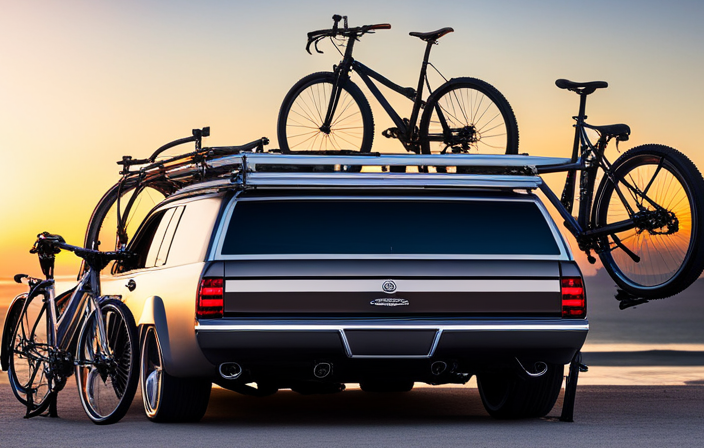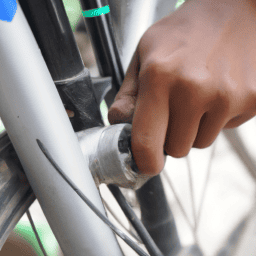Did you know that more than 47 million Americans participate in cycling for recreation?
If you’re one of them and need to transport your bicycle in a truck bed, it’s essential to secure it properly to prevent damage or accidents.
In this article, I will guide you through the step-by-step process of tying down your bicycle in a truck bed.
By following these practical tips, you can ensure a safe and hassle-free journey for both you and your beloved bike.
Key Takeaways
- Using a Bicycle Rack or Mount (roof mounts, hitch mounts, tailgate pads, bed mounts, truck bed racks) is a reliable method of securing the bike in the truck bed.
- Using Protective Padding or Covers (protective padding, covers, waterproof covers, custom-fit covers, investing in protective padding and covers) helps protect the bike during transportation.
- It is important to follow Local Transportation Laws and Regulations (adhering to local laws, checking for specific rules, securing bike with additional straps, restrictions on number of bikes) to ensure safe and legal transportation of the bike.
- Driving Safely and Avoiding Sudden Movements (securing the bike properly, maintaining safe speed and distance, avoiding sudden movements, safe driving is crucial) is essential for the safe transportation of the bike in the truck bed.
Gather the Necessary Equipment
You’ll need to gather the necessary equipment before tying down your bicycle in the truck bed. Equipment selection is important to ensure your bike stays secure during transport. Start by getting a set of high-quality ratchet straps or bungee cords. These will provide the necessary tension to keep your bike in place.
Additionally, consider investing in a truck bed bike rack or a tailgate pad for added stability. Proper tie down techniques are crucial to prevent any damage to your bike or truck. Make sure to loop the straps through the bike frame, securing it tightly. It’s also a good idea to use padding or towels to protect your bike from scratches.
With the right equipment and tie down techniques, you can transport your bicycle safely and securely in your truck bed. Now, let’s move on to preparing the truck bed.
Prepare the Truck Bed
First, make sure the truck bed is ready. To properly secure your bicycle, follow these steps for truck bed installation and securing cargo:
-
Install a truck bed bike rack: Choose a suitable bike rack that fits your truck bed and securely attach it. This will provide a stable framework for tying down your bicycle.
-
Use ratchet straps: Ratchet straps are strong and adjustable, making them ideal for securing your bike. Attach the straps to the bike rack and tightly fasten them around the frame and wheels.
-
Utilize bungee cords: Bungee cords can be used to further secure loose parts, such as handlebars or pedals. Attach them to the bike frame and any available anchor points in the truck bed.
Now that the truck bed is prepared, it’s time to move on to the next step: removing the front wheel.
Remove the Front Wheel
Once the front wheel is removed, it will be easier to secure your bike in the truck.
To remove the front wheel, start by loosening the quick release lever or unscrewing the axle nuts on both sides of the wheel. Once loose, lift the bike slightly and slide the wheel out of the front fork. Make sure to keep the wheel in a safe place, so it doesn’t get damaged or lost.
With the front wheel removed, you can now focus on securing the front fork. Place the bike in the truck bed with the front fork facing towards the front of the truck. Use soft padding or a bike mount to secure the fork to the truck bed, ensuring it’s tightly fastened.
Now that the front wheel is off and the front fork is secured, we can move on to positioning the bicycle in the truck bed.
Position the Bicycle in the Truck Bed
To properly position your bike in the truck bed, make sure it is centered and aligned with the truck’s axis. This will ensure stability and prevent any unnecessary movement during transportation. When positioning your bike, consider using positioning techniques that maximize space and prevent damage. One effective method is to place the bike upright with the front wheel facing towards the truck’s cab. This allows for better weight distribution and minimizes the risk of the bike tipping over. Additionally, you can utilize a table like the one below to visualize different positioning options:
| Positioning Technique | Description | Advantages |
|---|---|---|
| Upright | Front wheel facing the cab | Better weight distribution, minimal tipping risk |
| Sideways | Bike lying sideways | Maximize space, easy access |
Once you have positioned your bike, it’s time to secure the frame to the truck bed, ensuring that it stays in place throughout the journey.
Secure the Frame to the Truck Bed
Now it’s important to make sure the frame is securely fastened to the truck bed. To ensure a safe and worry-free journey, there are various tying methods you can use.
-
Ratchet Straps: These reliable straps offer excellent tension control, keeping your bicycle firmly in place throughout the ride.
-
Bungee Cords: Known for their flexibility, bungee cords are a quick and easy solution to secure your bike. However, they may not provide the same level of stability as ratchet straps.
-
Cam Buckle Straps: These straps are simple to use and have a strong grip, ensuring your bike stays in position. They are a great alternative if you don’t have ratchet straps available.
By securely fastening the frame using one of these tying methods, you can have peace of mind knowing your bike will stay put during transportation.
Now, let’s move on to the next section and discuss the use of tie-down straps or bungee cords.
Use Tie-Down Straps or Bungee Cords
Using tie-down straps or bungee cords is a practical way to secure your bike during transportation. These straps are specifically designed for securing items in a truck bed and provide a strong and reliable hold.
However, if you don’t have tie-down straps or bungee cords on hand, you can also use rope as an alternative method for securing your bicycle. Just make sure the rope is strong enough to withstand the weight and won’t easily come undone.
When using rope, it’s important to create multiple secure attachment points to prevent any shifting or movement of the bike during transit. Once you have secured the frame of the bike to the truck bed, you can then proceed to attach the bicycle to anchor points using the same or alternative methods.
Attach the Bicycle to Anchor Points
First, make sure there are secure anchor points available to attach your bike during transportation. If your truck bed doesn’t have built-in anchor points, there are alternative options.
One option is to use a truck bed bike rack that securely attaches to the sides or tailgate of the truck bed. These racks usually have adjustable straps or clamps that hold the bike in place.
Another option is to use a fork mount bike rack. This type of rack attaches to the truck bed and holds the bike by the front fork, keeping it stable.
If you don’t have any anchor points or racks available, you can secure the bike by using ratchet straps or bungee cords to tie it down to the truck bed. Just make sure to loop the straps or cords around the frame and wheels to prevent any movement.
Now, let’s double-check the security of the bicycle before hitting the road.
Double-Check the Security of the Bicycle
Before hitting the road, make sure to double-check that the bike is securely attached and won’t move during transport.
Start by checking the bike locks to ensure they are properly engaged and tightened. Give each lock a gentle tug to make sure it holds the bike firmly in place.
Additionally, consider using additional security measures such as a cable lock or bungee cords to further secure the bike to the anchor points. These extra measures can provide peace of mind and prevent any unwanted movement or shifting during the journey.
Once you are confident in the bike’s security, it’s time to test the stability of the bicycle by giving it a gentle shake and ensuring it remains firmly in place. This step will help ensure a safe and worry-free transportation experience.
Test the Stability of the Bicycle
After double-checking the security of your bicycle in the truck bed, it’s important to test the stability of the bike before hitting the road.
There are a few test methods you can use to ensure the bike is securely tied down. First, give the bike a gentle push from different angles to see if it wobbles or shifts. If it does, you may need to adjust the straps or reposition the bike.
Next, try giving the truck bed a few light shakes to see if the bike stays in place. If it moves, you’ll need to secure it further.
Once you’ve completed these tests, analyze the results and make any necessary adjustments to ensure the bike is stable and won’t shift during transport.
Now, let’s consider using a bicycle rack or mount for added security and ease of transportation.
Consider Using a Bicycle Rack or Mount
For added security and ease of transportation, you might want to consider using a bicycle rack or mount on your vehicle. There are several bicycle mount options available, each with its own advantages and disadvantages.
Here are some alternative transportation methods to consider:
-
Roof mounts: These mounts attach to the roof of your truck bed and are great for carrying multiple bikes. However, they may require additional lifting and can affect your vehicle’s aerodynamics.
-
Hitch mounts: These mounts attach to the hitch receiver of your truck and are easy to install. They provide a stable and secure way to transport your bike but may limit access to your truck bed.
-
Tailgate pads: These pads wrap around your truck’s tailgate and provide a soft surface for your bike to rest on. They are easy to use but may not be as secure as other options.
-
Bed mounts: These mounts secure your bike to the bed of your truck using straps or clamps. They are versatile and easy to install, but they may take up valuable space in your truck bed.
-
Truck bed racks: These racks sit inside your truck bed and provide a dedicated space for your bike. They are sturdy and secure, but they may limit the amount of cargo you can carry.
When considering which option is best for you, take into account your specific needs and preferences. Once you have chosen a mount, it’s important to use protective padding or covers to prevent any damage to your bike during transportation.
Use Protective Padding or Covers
To ensure the safety of your bike during transportation, make sure to use protective padding or covers. This will prevent any scratches, dents, or other damage that could occur while your bike is in the truck bed. Protective padding provides a cushioning layer between your bike and the truck bed, absorbing any shocks or vibrations that may occur during transit. Additionally, using a cover can protect your bike from dust, dirt, and the elements, keeping it clean and in good condition. There are various cover options available, such as waterproof covers or custom-fit covers designed specifically for bike transportation. Investing in protective padding and covers is a small price to pay to ensure the longevity and well-being of your bike during transportation. Now, let’s move on to the next section about following local transportation laws and regulations.
Follow Local Transportation Laws and Regulations
It’s important to adhere to local transportation laws and regulations when transporting your bike. These regulations are put in place to ensure the safety of both you and other drivers on the road.
Before loading your bike onto the truck bed, make sure to check if there are any specific rules or requirements regarding the transportation of bicycles. Some areas may require you to secure your bike with additional straps or tie-downs, while others may have restrictions on the number of bikes you can transport at once.
Additionally, always take safety precautions when transporting your bike, such as using reflective gear and ensuring that your bike is properly secured to prevent any accidents or damage.
By following these transportation regulations and safety measures, you can ensure a smooth and stress-free journey with your bike.
And remember, drive safely and avoid sudden movements to keep your bike and yourself safe on the road.
Drive Safely and Avoid Sudden Movements
Always drive safely and avoid sudden movements when transporting your bike. Safe driving is crucial to ensure that your bike remains secure in the truck bed and to prevent accidents on the road.
Start by securing your bike properly using tie-down straps or a bike rack designed for truck beds. Make sure the straps are tight and the bike is stable before you hit the road.
When driving, be mindful of your speed and maintain a safe following distance from other vehicles. Avoid sudden braking, accelerating, or swerving, as these movements can cause your bike to shift or even fall off the truck bed.
By driving safely and avoiding any sudden movements, you can ensure a smooth journey for your bike.
As we move on to the next section about regularly checking the bicycle during the journey, it’s important to keep in mind that safe driving is the foundation for a successful bike transportation.
Regularly Check the Bicycle during the Journey
During the journey, make sure to regularly check your bike to ensure it remains secure and undamaged. This is important because even with proper tie-down techniques, there are potential risks and hazards that can cause the bike to shift or become loose.
I recommend checking the bike at regular intervals, especially after encountering bumpy roads or sharp turns. Look for any signs of movement or damage to the tie-down straps. Additionally, inspect the bike itself for any loose parts or adjustments that may need to be made. By performing these checkpoints during travel, you can catch any issues early on and prevent further damage or accidents.
As we move on to the next section about unloading the bicycle safely, it’s important to ensure its stability throughout the entire journey.
Unload the Bicycle Safely
To safely unload the bike, carefully remove it from the vehicle without causing any damage. Here are five steps to unload your bicycle safely and secure it properly:
-
Start by checking the surroundings of your truck bed to ensure there are no obstacles or hazards that could cause any accidents or damage to your bike.
-
Carefully lift the bike out of the truck bed, making sure to maintain a firm grip on the handlebars and frame to prevent any unnecessary movement or potential scratches.
-
Place the bike on a flat surface, such as the ground or a bike rack, ensuring that it is stable and won’t tip over.
-
Remove any straps or tie-downs that were used to secure the bike in the truck bed, taking care not to damage any components or scratch the bike’s frame.
-
Once the bike is unloaded, inspect it for any signs of damage or loose components before embarking on your ride.
Remember, taking the time to unload your bike safely and securely will help ensure that it is ready for your next adventure.
Frequently Asked Questions
How do I properly remove the front wheel of my bicycle to secure it in the truck bed?
To properly remove the front wheel of my bicycle and secure it in the truck bed, I first need to loosen the axle nuts or quick release lever. Then, I can slide the wheel off, making sure to keep it upright to avoid any damage.
Are there any specific anchor points in the truck bed that I should use to attach the bicycle?
To secure a bicycle in a truck bed, utilize the truck bed anchor points for proper attachment. These points ensure stability and prevent any shifting during transportation, keeping your bike safe and secure.
What are some alternative options to using tie-down straps or bungee cords to secure the bicycle?
When securing a bicycle in a truck bed, there are alternative options to tie-down straps and bungee cords. Consider using a bike rack, a cargo net, or ratchet straps for a more secure and reliable method of securing your bike.
Are there any specific transportation laws or regulations regarding transporting bicycles in a truck bed?
Transportation laws and regulations vary by jurisdiction, but it’s important to secure bicycles properly in a truck bed to prevent accidents and damage. Understanding local laws, using appropriate tie-downs, and ensuring a stable position are key considerations.
How often should I check the security and stability of the bicycle during the journey?
I should check the security and stability of my bicycle regularly during the journey. This ensures that it stays in place and doesn’t shift or fall over, preventing any damage or accidents while transporting it in the truck bed.
Conclusion
In conclusion, tying down a bicycle in a truck bed is a simple and practical task that can be done with a few easy steps.
By gathering the necessary equipment, preparing the truck bed, and securing the frame properly, you can ensure a safe and secure journey for your bicycle.
Remember to follow local transportation laws and regulations, drive safely, and regularly check on your bicycle during the journey.
With these precautions in place, your bike will be as snug as a bug in a rug for the ride ahead.









